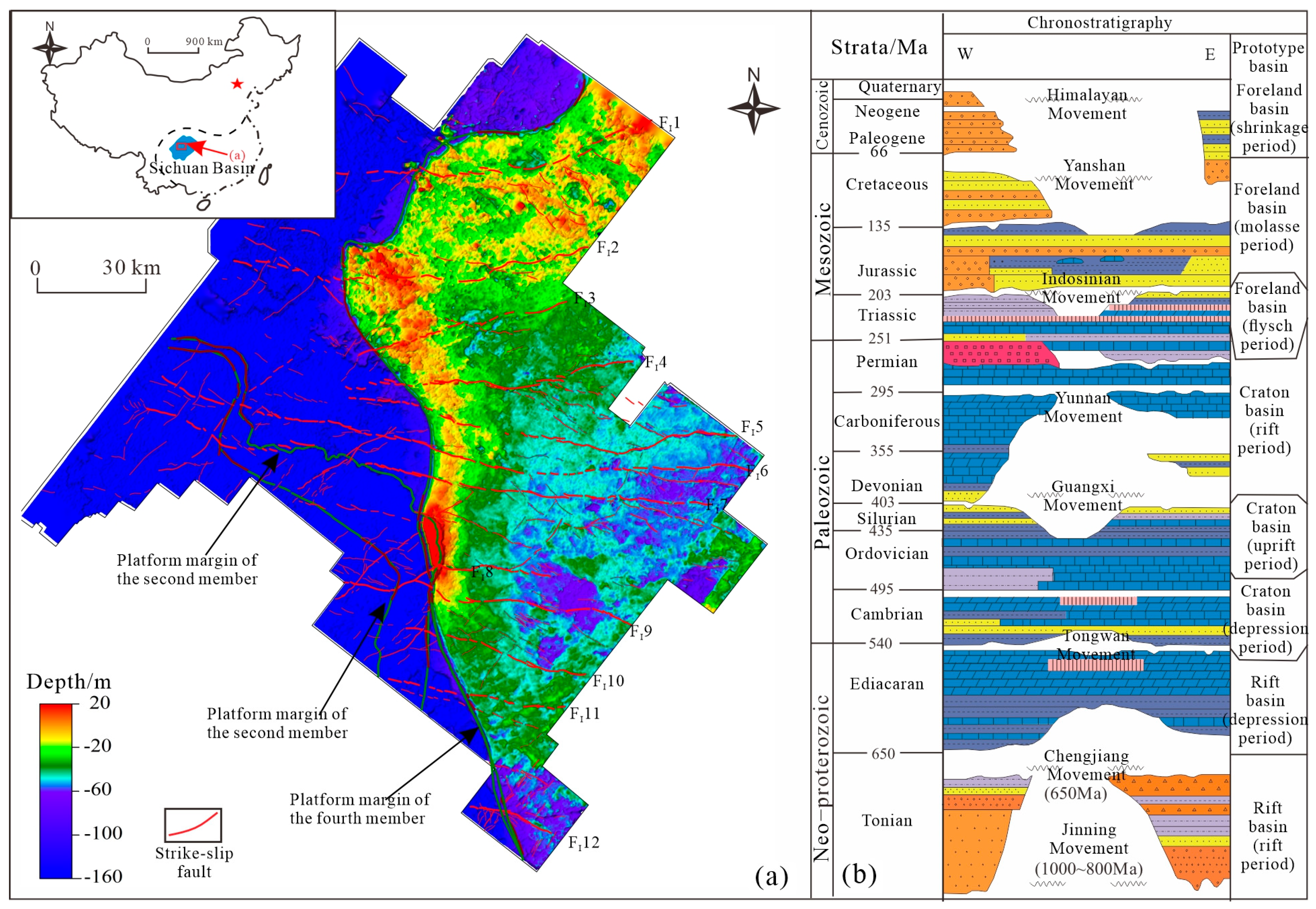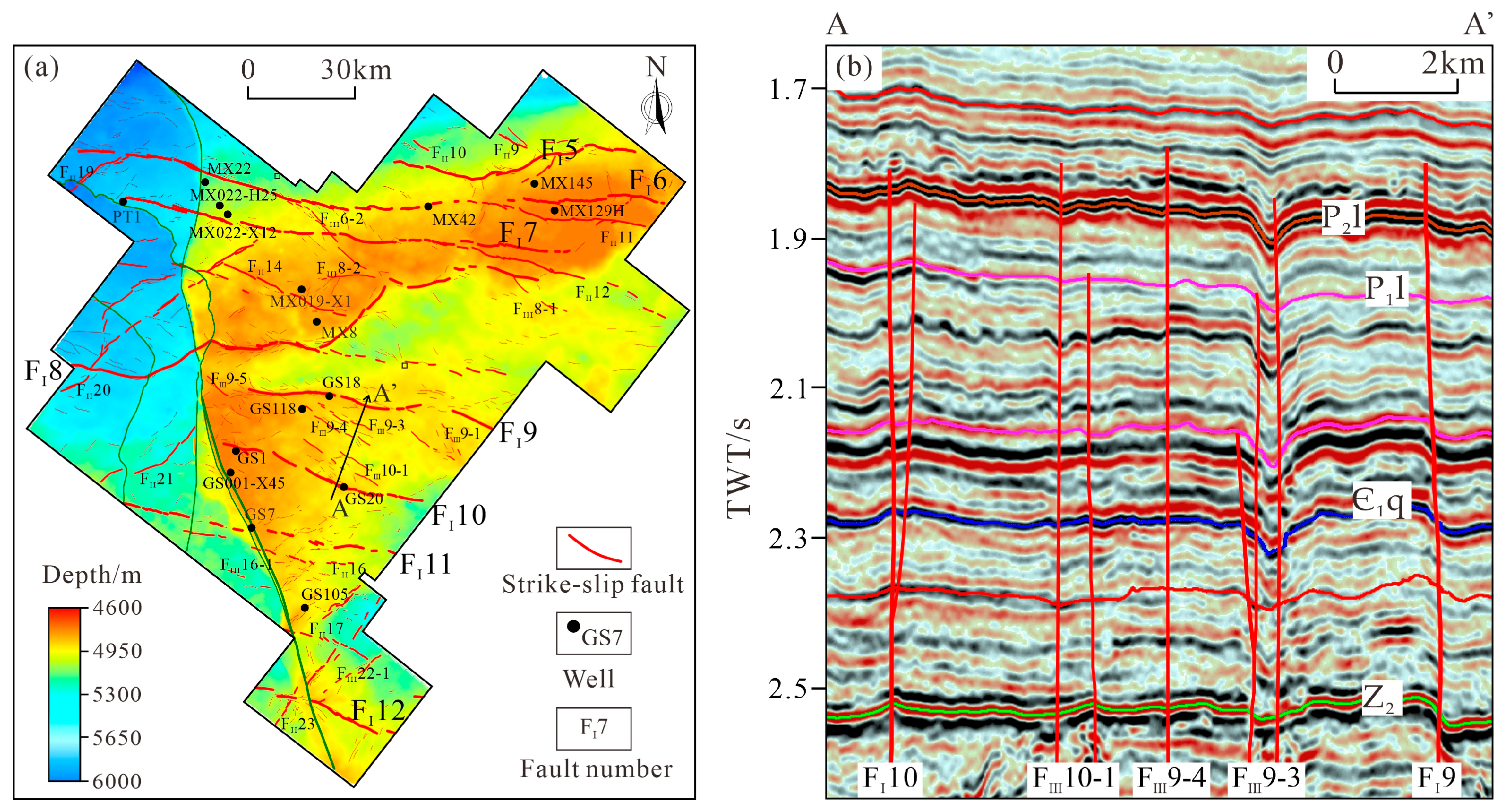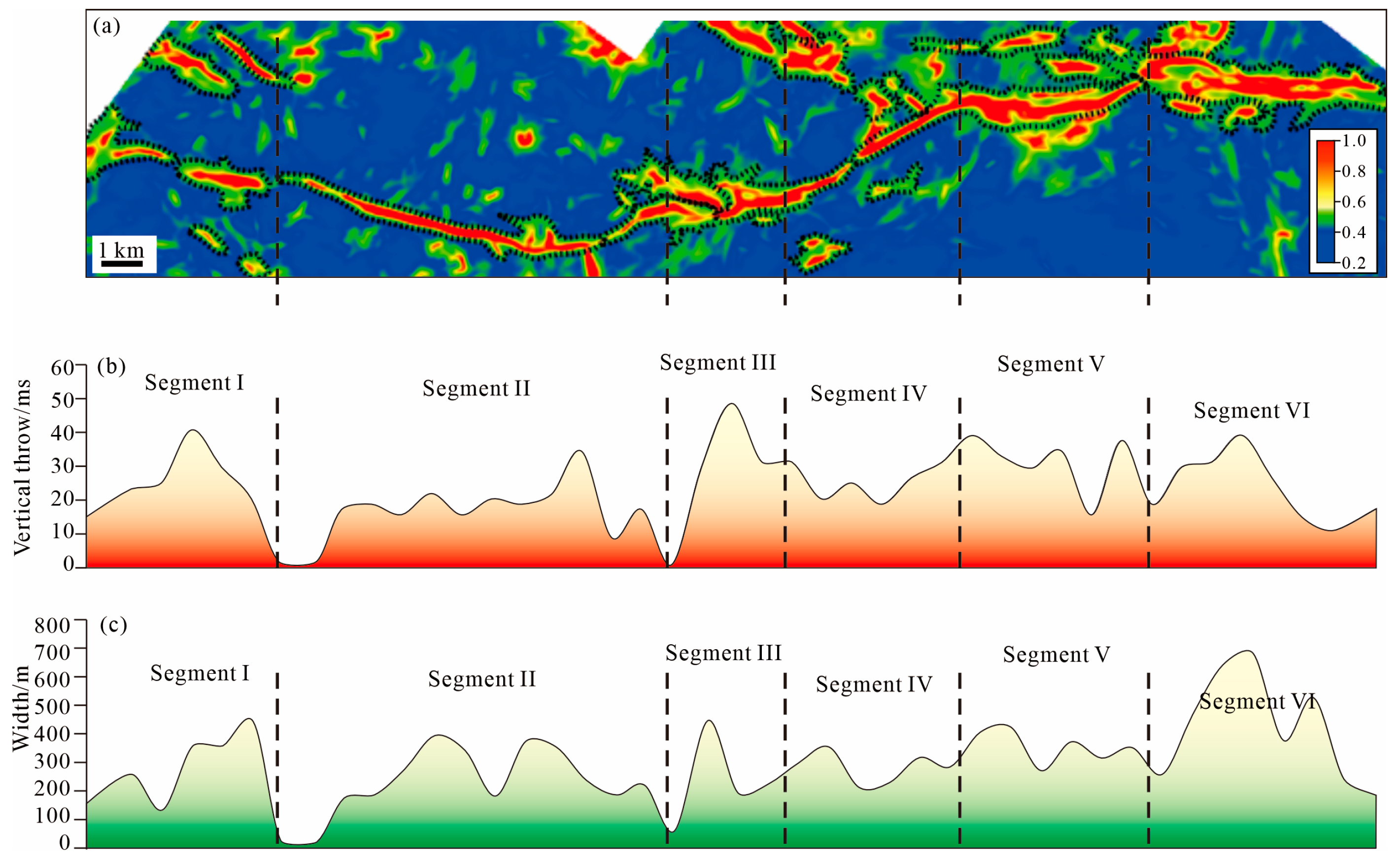The Seismic Identification of Small Strike-Slip Faults in the Deep Sichuan Basin (SW China)
Abstract
:1. Introduction
2. Geological Background
3. Methods
4. Results
4.1. Improving the Seismic Resolution of the Strike-Slip Faults
4.2. Discovery and Mapping of Small Strike-Slip Faults
5. Discussions
5.1. Seismic Methods for Improving the Resolution of Strike-Slip Faults
5.2. Characterization of Strike-Slip Faults and Fractured Reservoirs
6. Conclusions
Author Contributions
Funding
Data Availability Statement
Acknowledgments
Conflicts of Interest
References
- Caine, J.S.; Evans, J.P.; Forster, C.B. Fault zone architecture and permeability structure. Geology 1996, 24, 1025–1028. [Google Scholar] [CrossRef]
- Collettini, C.; Niemeijer, A.; Viti, C.; Marone, C. Fault zone fabric and fault weakness. Nature 2009, 462, 907–910. [Google Scholar] [CrossRef] [PubMed]
- Bense, V.F.; Gleeson, T.; Loveless, S.E.; Bour, O.; Scibek, J. Fault zone hydrogeology. Earth-Sci. Rev. 2013, 127, 171–192. [Google Scholar] [CrossRef]
- Ross, Z.E.; Cochran, E.S.; Trugman, D.T.; Jonathan, S. 3D fault architecture controls the dynamism of earthquake swarms. Science 2020, 368, 1357–1361. [Google Scholar] [CrossRef] [PubMed]
- Faulkner, D.R.; Jackson, C.A.L.; Lunn, R.J.; Schlische, R.W.; Shipton, Z.K.; Wibberley, C.A.J.; Withjack, M.O. A review of recent developments concerning the structure, mechanics and fluid flow properties of fault zones. J. Struct. Geol. 2010, 32, 1557–1575. [Google Scholar] [CrossRef]
- Choi, J.H.; Edwards, P.; Ko, K.; Kim, Y.S. Definition and classification of fault damage zones: A review and a new methodological approach. Earth-Sci. Rev. 2016, 152, 70–87. [Google Scholar] [CrossRef]
- Abdallah, K.B.; Souissi, S.; Hamdi, E.; Ghomari, S. Fractured reservoirs: An extensive geomechanical integrity approach. Geoenergy Sci. Eng. 2024, 233, 212572. [Google Scholar] [CrossRef]
- Qi, J.; Lyu, B.; AlAli, A.; Machado, G.; Hu, Y.; Marfurt, K. Image processing of seismic attributes for automatic fault extraction. Geophysics 2018, 84, 25–37. [Google Scholar] [CrossRef]
- Li, X.; Li, K.W.; Xu, Z.F.; Huang, Z.C.; Dou, Y.M. Fault-Seg-Net: A method for seismic fault segmentation based on multi-scale feature fusion with imbalanced classification. Comput. Geotech. 2023, 158, 105412. [Google Scholar] [CrossRef]
- Sun, C.; Shen, F.X.; Wen, Z.; Zhang, Y.Y.; Scarselli, N.; Li, S.Y.; Yu, Y.L.; Wu, G.H. Seismic analysis of fault damage zones in the northern Tarim Basin (NW China): Implications for growth of ultra-deep fractured reservoirs. J. Asian Earth Sci. 2023, 255, 105778. [Google Scholar] [CrossRef]
- Zhou, Y.; Tang, H.Y.; Zhang, J.M.; He, T. Application of comprehensive geophysical analysis in hidden fault exploration. Appl. Geophys. 2020, 17, 1–10. [Google Scholar] [CrossRef]
- Famiani, D.; Cara, F.; Di Giulio, G.; Vassallo, M.; Milana, G. Detection of hidden faults within the Fucino basin from single-station ambient noise measurements: The case study of the Trasacco fault system. Front. Earth Sci. 2022, 10, 937848. [Google Scholar] [CrossRef]
- Wang, E.L.; Li, H.L.; He, R.; Zhao, W.J.; Li, L.; Xie, C.H.; Yan, G.L.; Chen, Q.Y.; Yang, Q. A tiny-fault detection strategy based on phase congruency—An example of carbonate reservoir in Ordos Basin, China. Minerals 2023, 13, 030306. [Google Scholar] [CrossRef]
- Otchere, D.A.; Tackie-Otoo, B.N.; Mohammad, M.A.A.; Ganat, T.O.A.; Kuvakin, N.; Miftakhov, R.; Efremov, I.; Bazanov, A. Improving seismic fault mapping through data conditioning using a pre-trained deep convolutional neural network: A case study on Groningen field. J. Pet. Sci. Eng. 2022, 213, 110411. [Google Scholar] [CrossRef]
- Zhu, D.L.; Li, L.; Guo, R.; Tao, C.F.; Zhan, S.F. 3D fault detection: Using human reasoning to improve performance of convolutional neural networks. Geophysics 2022, 87, 143–156. [Google Scholar] [CrossRef]
- Wang, Q.H.; Zhang, Y.T.; Xie, Z.; Zhao, Y.W.; Zhang, C.; Sun, C.; Wu, G.H. The Advance and challenge of seismic technique on the ultra-deep carbonate reservoir exploitation in the Tarim Basin, Western China. Energies 2022, 15, 7653. [Google Scholar] [CrossRef]
- He, X.; Guo, G.; Tang, Q.; Wu, G.; Xu, W.; Ma, B.; Huang, T.; Tian, W. The advances and challenges of the Ediacaran fractured reservoir development in the central Sichuan Basin, China. Energies 2022, 15, 8137. [Google Scholar] [CrossRef]
- Chen, L.; Jiang, Z.; Sun, C.; Ma, B.; Su, Z.; Wan, X.; Han, J.; Wu, G. An overview of the differential carbonate reservoir characteristic and exploitation challenge in the Tarim Basin (NW China). Energies 2023, 16, 5586. [Google Scholar] [CrossRef]
- Zhu, Y.F.; Zhang, Y.T.; Zhao, X.X.; Xie, Z.; Wu, G.H.; Li, T.; Yang, S.; Kang, P.F. The fault effects on the oil migration in the ultra-deep Fuman Oilfield of the Tarim Basin, NW China. Energies 2022, 15, 5789. [Google Scholar] [CrossRef]
- Wu, G.H.; Zhao, K.Z.; Qu, H.Z.; Nicola, S.; Zhang, Y.T.; Han, J.F.; Xu, Y.F. Permeability distribution and scaling in multi-stages carbonate damage zones: Insight from strike-slip fault zones in the Tarim Basin, NW China. Mar. Pet. Geol. 2020, 114, 104208. [Google Scholar] [CrossRef]
- He, X.; Tang, Q.S.; Wu, G.H.; Li, F.; Tian, W.Z.; Luo, W.J.; Ma, B.S.; Su, C. Control of strike-slip faults on Sinian carbonate reservoirs in Anyue gasfield, Sichuan Basin, SW China. Pet. Explor. Dev. 2023, 50, 1282–1294. [Google Scholar] [CrossRef]
- Jiao, F.; Yang, Y.; Ran, Q.; Wu, G.; Liang, H. Distribution and gas exploration of the strike–slip faults in the central Sichuan Basin. Nat. Gas Ind. B 2021, 41, 59–68, (In Chinese with English Abstract). [Google Scholar] [CrossRef]
- Ma, B.S.; Liang, H.; Wu, G.H.; Tang, Q.S.; Tian, W.Z.; Zhang, C.; Yang, S.; Zhong, Y.; Zhang, X.; Zhang, Z.L. Formation and evolution of the strike-slip faults in the central Sichuan Basin, SW China. Pet. Explor. Dev. 2023, 50, 333–345. [Google Scholar] [CrossRef]
- Tian, X.W.; Liu, G.D.; Luo, B.; Yang, Y.; Wen, L.; Zhang, B.J.; Chen, X.; Su, G.; Song, Z.; Peng, H.; et al. Structural characteristics and their significance for hydrocarbon accumulation in the northern slope of the central Sichuan Paleo-uplift. Acta Geol. Sin. 2022, 96, 1451–1470. [Google Scholar] [CrossRef]
- He, B.; Liu, Y.; Qiu, C.; Liu, Y.; Su, C.; Tang, Q.; Tian, W.; Wu, G. The strike-slip fault effects on the Ediacaran carbonate tight reservoirs in the central Sichuan Basin, China. Energies 2023, 16, 4041. [Google Scholar] [CrossRef]
- Liang, S.Z.; Li, Z.; Zhang, W.; Gao, Y. The characteristics of strike-slip faults and their control on hydrocarbon distribution in deep carbonate reservoirs of the central Sichuan Basin. Front. Earth Sci. 2023, 11, 64835. [Google Scholar] [CrossRef]
- He, D.; Li, D.; Zhang, G.; Zhao, L.; Fan, C.; Lu, R.; Wen, Z. Formation and evolution of multi-cycle superposed Sichuan Basin, China. Chin. J. Geol. 2011, 46, 589–606, (In Chinese with English Abstract). [Google Scholar]
- Gu, Z.D.; Wang, Z.C.; Hu, S.Y.; Wang, H.; Yin, J.F.; Huang, P.H. Tectonic settings of global marine carbonate giant fields and exploration significance. Nat. Gas Geosci. 2012, 23, 106–118, (In Chinese with English Abstract). [Google Scholar]
- Liu, S.G.; Yang, Y.; Deng, B.; Zhong, Y.; Wen, L.; Sun, W.; Li, Z.W.; Jansa, L.; Li, J.X.; Song, J.M.; et al. Tectonic evolution of the Sichuan Basin, Southwest China. Earth-Sci. Rev. 2021, 213, 103470. [Google Scholar] [CrossRef]
- Zou, C.N.; Du, J.H.; Xu, C.C.; Wang, Z.C.; Zhang, B.M.; Wei, G.Q.; Wang, T.S.; Yao, G.S.; Deng, S.H.; Liu, J.J.; et al. Formation, distribution, resource potential and discovery of the Sinian−Cambrian giant gas field, Sichuan Basin, SW China. Petrol. Explor. Dev. 2014, 41, 306–325. [Google Scholar] [CrossRef]
- Xu, C.C.; Shen, P.; Yang, Y.M.; Zhao, L.Z.; Luo, B.; Wen, L.; Chen, K.; Ran, Q.; Zhong, Y.; Peng, H.L. New understandings and potential of Sinian-Lower Paleozoic natural gas exploration in the central Sichuan paleo-uplift of the Sichuan Basin. Nat. Gas Ind. 2021, 8, 105–113, (In Chinese with English Abstract). [Google Scholar] [CrossRef]
- Wen, L.; Ran, Q.; Tian, W.; Liang, H.; Zhong, Y.; Zou, Y.; Su, C.; Wu, G. Strike-Slip Fault Effects on Diversity of the Ediacaran Mound-shoal Distribution in the Central Sichuan Intracratonic Basin, China. Energies 2022, 15, 5910. [Google Scholar] [CrossRef]
- Tang, Q.; Tang, S.; Luo, B.; Luo, X.; Feng, L.; Li, S.; Wu, G. Seismic description of deep strike-slip fault damage zone by steerable pyramid method in the Sichuan Basin, China. Energies 2022, 15, 8131. [Google Scholar] [CrossRef]
- Torabia, A.; Berg, S.S. Scaling of fault attributes: A review. Mar. Pet. Geol. 2011, 28, 1444–1460. [Google Scholar] [CrossRef]
- Wu, G.H.; Gao, L.H.; Zhang, Y.T.; Ning, C.Z.; Xie, E. Fracture attributes in reservoir-scale carbonate fault damage zones and implications for damage zone width and growth in the deep subsurface. J. Struct. Geol. 2019, 118, 181–193. [Google Scholar] [CrossRef]
- Goswami, T.K.; Mahanta, B.N.; Mukherjee, S.; Syngai, B.R.; Sarmah, R.K. Orogen-transverse structures in the eastern Himalaya: Dextral Riedel shear along the main boundary thrust in the Garu-Gensi area (Arunachal Pradesh, India), implication in hydrocarbon geoscience. Mar. Pet. Geol. 2020, 114, 104242. [Google Scholar] [CrossRef]
- Wu, G.H.; Kim, Y.S.; Su, Z.; Yang, P.F.; Ma, D.B.; Zheng, D.M. Segment interaction and linkage evolution in a conjugate strike-slip fault system from the Tarim Basin. Mar. Pet. Geol. 2019, 112, 104054. [Google Scholar] [CrossRef]











Disclaimer/Publisher’s Note: The statements, opinions and data contained in all publications are solely those of the individual author(s) and contributor(s) and not of MDPI and/or the editor(s). MDPI and/or the editor(s) disclaim responsibility for any injury to people or property resulting from any ideas, methods, instructions or products referred to in the content. |
© 2024 by the authors. Licensee MDPI, Basel, Switzerland. This article is an open access article distributed under the terms and conditions of the Creative Commons Attribution (CC BY) license (https://creativecommons.org/licenses/by/4.0/).
Share and Cite
Li, H.; Liu, J.; Zheng, M.; Li, S.; Long, H.; Li, C.; Huang, X. The Seismic Identification of Small Strike-Slip Faults in the Deep Sichuan Basin (SW China). Processes 2024, 12, 1508. https://doi.org/10.3390/pr12071508
Li H, Liu J, Zheng M, Li S, Long H, Li C, Huang X. The Seismic Identification of Small Strike-Slip Faults in the Deep Sichuan Basin (SW China). Processes. 2024; 12(7):1508. https://doi.org/10.3390/pr12071508
Chicago/Turabian StyleLi, Hai, Jiawei Liu, Majia Zheng, Siyao Li, Hui Long, Chenghai Li, and Xuri Huang. 2024. "The Seismic Identification of Small Strike-Slip Faults in the Deep Sichuan Basin (SW China)" Processes 12, no. 7: 1508. https://doi.org/10.3390/pr12071508



